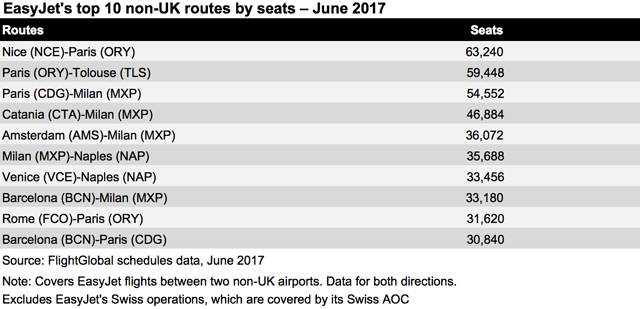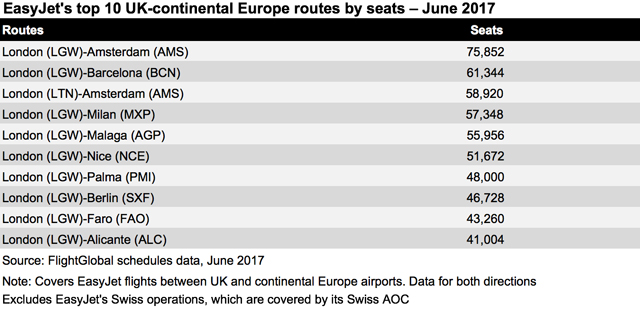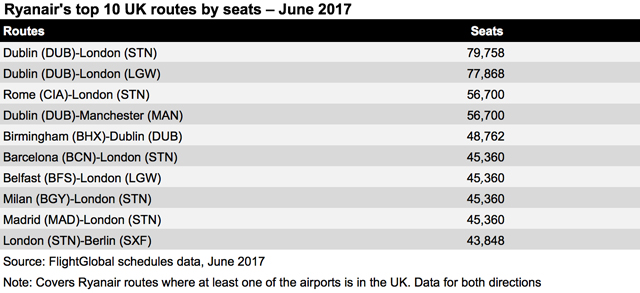With the countdown well under way for the UK's departure from the EU, Europe's two biggest low-cost carriers have plenty of reasons to take a keen interest in the progress of negotiations.
The various operators based in the UK or with a strong presence there have traded differing views on who would face the most challenges in the event of a "hard Brexit", but it is clear that, from a network perspective, the big low-cost carriers have a number of different aspects to factor in.
Those low-cost carriers, free of the same level of national and hub obligations that network airlines face, have used the flexibility to operate across Europe, expanding their footprints and linking markets across the continent. The key concern for EasyJet and Ryanair, among a number of airlines potentially affected, is what will happen if the UK fails to remain part of Europe's single market in air services when Brexit negotiations conclude.
While agreement to become a member of the European Common Aviation Area would allay fears, there have been few signals that such an outcome is likely. A new bilateral agreement between the UK and the EU is another option, but that would carry challenges of its own for airlines.

Under a scenario where no agreement is forthcoming, UK-based EasyJet could lose its right to serve EU destinations from its home country. It could also lose the right – enshrined in the UK's EU membership and through the ECAA, which gives access to non-EU countries including Norway and Iceland – to fly between two non-UK airports in Europe.
The only exception to this would be its services involving Switzerland. EasyJet has a Swiss AOC after taking over TEA Basel operations in 1998. Switzerland is outside the EU but has a restricted agreement to take part in the wider European single aviation market.
Meanwhile, Ireland-based Ryanair's concern is that it could lose its right to serve EU and ECAA countries from the UK.
"It is important air travel isn't disrupted and we don't have a period of uncertainty, or we don't have a period where you can't have flights between the UK and Europe," said Kenny Jacobs, Ryanair's chief marketing officer, during the recent Routes Europe event in Belfast.
Analysis of FlightGlobal schedules data for June 2017 shows that in terms of seats, 36% of EasyJet's services – excluding those to and from Switzerland – are on routes that do not touch UK airports. In the same month, 35% of Ryanair's seats are on routes where at least one of the airports is in the UK.

EasyJet has a number of bases in other EU and ECAA countries, but no European AOC. It is working to secure one so that it can still be considered an EU carrier, whatever the outcome of the UK's negotiations. Without that AOC, flights accounting for 36% of its seats could be under threat even if the UK managed to negotiate a new bilateral agreement with the EU.
"We are making good progress and are on track to meet the timetable previously announced of having the AOC awarded during summer 2017," EasyJet told FlightGlobal on 4 May.
Another complicating factor for EasyJet, increasing the importance of its establishment of an EU AOC, was highlighted in a UK House of Lords select committee report published earlier this year. It concluded: "We note that there is no precedent for the inclusion of the right to fly domestically within an EU member state in a comprehensive bilateral air services agreement." This suggests that EasyJet's domestic French services, for example, could be under threat in a scenario where the UK secures a bilateral EU agreement but the airline has no EU AOC in place.
Two French domestic routes – Nice-Paris and Paris-Toulouse – are EasyJet's busiest in terms of seats in its non-UK network in June, FlightGlobal schedules data shows. Excluding flights covered by its Swiss AOC, 2.4 million, or 36%, of EasyJet's 6.8 million seats in June are on routes that do not touch UK airports. Including those Swiss routes, 3.5 million, or 43%, of its 8.2 million seats in June are on non-UK routes.

A challenge for Ryanair is that its biggest base is in the UK, at London Stansted. Its two busiest UK routes in June this year are Dublin-Stansted and Dublin-London Gatwick. In total, 4.4 million of its 12.3 million seats in June are on services that touch at least one UK airport, FlightGlobal schedules data shows.
If UK operations no longer fall under the EU single market or ECAA and there is no replacement agreement, those Ryanair services would theoretically have to stop. Moreover, to avoid a situation where Ryanair loses the right to fly service originating in the UK, the country would need an air services agreement – joining the ECAA or otherwise – that allows EU carriers to base aircraft in the country and fly seventh-freedom services from it.

While the Brexit impact is by no means limited to these two low-cost carriers, the pan-European development of their networks means they have plenty at stake. In a scenario where the UK drops out of the European single aviation market with no replacement agreement, they could become victims of the success they have enjoyed through embracing the freedoms it confers.
Source: Cirium Dashboard


























